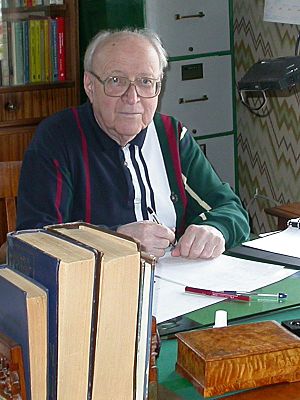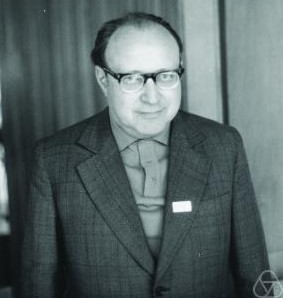Eugene Dynkin facts for kids
Quick facts for kids
Eugene Dynkin
|
|
|---|---|

Eugene Dynkin at home in 2003. Photo courtesy of the Dynkin Collection.
|
|
| Born |
Eugene Borisovich Dynkin
11 May 1924 |
| Died | 14 November 2014 (aged 90) |
| Citizenship | United States |
| Alma mater | Moscow University |
| Awards | Leroy P. Steele Prize (1993) |
| Scientific career | |
| Fields | Mathematics |
| Institutions | Moscow University Central Economic Mathematical Institute Cornell University |
| Doctoral advisor | Andrey Kolmogorov |
| Doctoral students | Nicolai V. Krylov Igor Girsanov Fridrikh Karpelevich Stanislav Molchanov Anatoliy Skorokhod Ernest Vinberg Complete List |
Eugene Borisovich Dynkin (Russian: Евгений Борисович Дынкин; 11 May 1924 – 14 November 2014) was a famous Soviet and American mathematician. He made important discoveries in probability and algebra. These include areas like Lie groups and Markov processes. Some mathematical ideas are even named after him. These are the Dynkin diagram, the Dynkin system, and Dynkin's lemma.
Contents
Biography
Eugene Dynkin was born into a Jewish family. They lived in Leningrad until 1935. Then, his family had to move to Kazakhstan. Two years later, when Eugene was 13, his father faced difficulties and disappeared.
Early Life and Moscow University
In 1940, at age 16, Dynkin started studying at Moscow University. He did not have to join the military during World War II. This was because of his poor eyesight. He earned his first degree in 1945 and his PhD in 1948.
He became an assistant professor at Moscow University. However, he faced challenges in his career. This was due to the political situation and his family background. His PhD supervisor, Andrey Kolmogorov, helped him a lot. This support allowed Dynkin to continue his studies and become a teacher.
Working for the USSR Academy of Sciences
In 1968, Dynkin had to leave Moscow University. He moved to the Central Economic Mathematical Institute. This institute was part of the USSR Academy of Sciences. There, he studied how economies grow and stay balanced.
Moving to Cornell University
Dynkin stayed at the Institute until 1976. Then, he moved to the United States. In 1977, he became a professor at Cornell University. He taught and researched there.
Later Years and Death
Eugene Dynkin passed away in Ithaca, New York. He was 90 years old.
Mathematical Work
Eugene Dynkin is special because he made big contributions to two different parts of mathematics. These are algebra and probability theory. His work in algebra was mostly from 1944 to 1954. But even then, he also showed interest in probability. His very first paper, in 1945, was about probability.
Lie Theory
When Dynkin was a student, he went to a seminar about Lie groups. In 1944, his professor asked him to study some complex papers. These papers were about classifying Lie groups. Dynkin found them hard to understand. To make it easier, he came up with the idea of a "simple root."
He then showed how these simple roots related to each other. He did this using a special drawing called a Dynkin diagram. This made it much clearer to understand and classify complex Lie algebras. In 1952, Dynkin wrote an important paper. It had many tables and lists. This paper looked at smaller parts of Lie algebras.
Probability Theory
Dynkin is seen as one of the people who started the modern study of Markov processes. These are mathematical models that describe systems changing over time. The results from Dynkin and his students were put into two books. The first book, "Theory of Markov Processes," came out in 1959. It set the basic rules for this field.
In 1962, Dynkin was supposed to give a talk in Stockholm. This was at a big meeting for mathematicians. But he was not allowed to travel to the West. So, his former supervisor, Andrey Kolmogorov, gave the talk for him. The talk was about Markov processes and analysis.
Prizes and Awards
Eugene Dynkin received many honors for his work:
- Prize of the Moscow Mathematical Society, 1951
- Institute of Mathematical Statistics, Fellow, 1962
- American Academy of Arts and Sciences, Fellow, 1978
- National Academy of Sciences of the USA, Member, 1985
- American Mathematical Society, Leroy P. Steele Prize for Total Mathematical Work, 1993
- Moscow Mathematical Society, Honorary Member, 1995
- Doctor Honoris Causa of the Pierre and Marie Curie University (Paris 6), 1997
- Doctor of Science (honoris causa) of the University of Warwick, 2003
- Doctor Honoris Causa of the Independent Moscow University (Russia), 2003
- Fellow of the American Mathematical Society, 2012
See also
 In Spanish: Eugene Dynkin para niños
In Spanish: Eugene Dynkin para niños
- Algebra
- Affine Dynkin diagram
- Coxeter–Dynkin diagram
- Dynkin index
- Dynkin–Specht–Wever Lemma
- Probability
- Dynkin's formula
- Dynkin system


